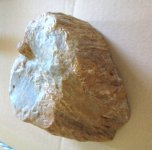olekyground
Bronze Member
- Apr 4, 2009
- 1,565
- 429
- Detector(s) used
-
garrett A.T. gold
Other detectors: fisher F2/ Garrett ace 250
- Primary Interest:
- All Treasure Hunting
Hey friend. I posted a couple days ago a find I found of what appears to be a cow or dog maybe? It's iron and it is rusted bad. I was wandering if anyone could tell me the best electrolysis set up so I can clean away all that funk from bigger objects as well as this one. thanks!!! 



 )
)


